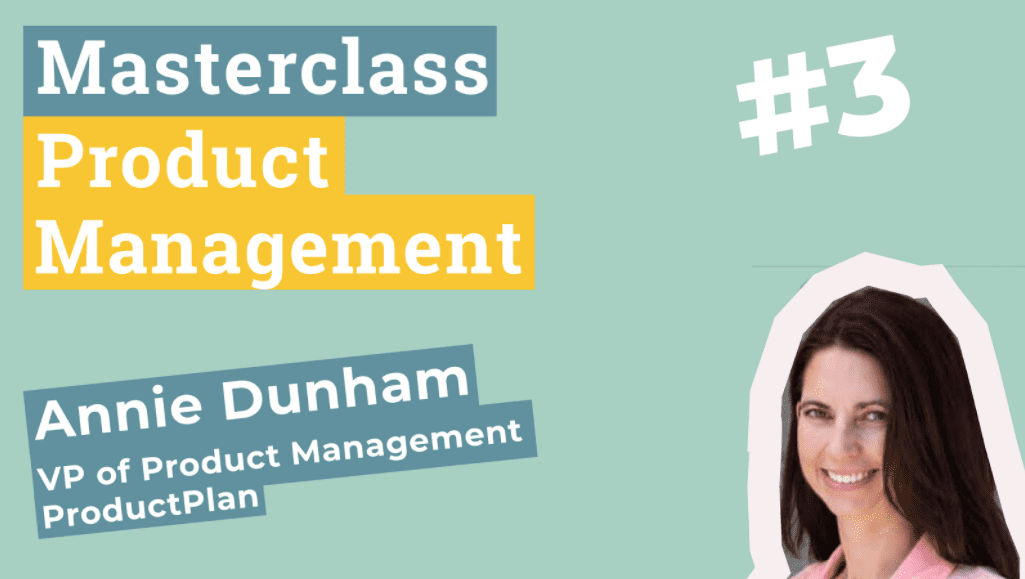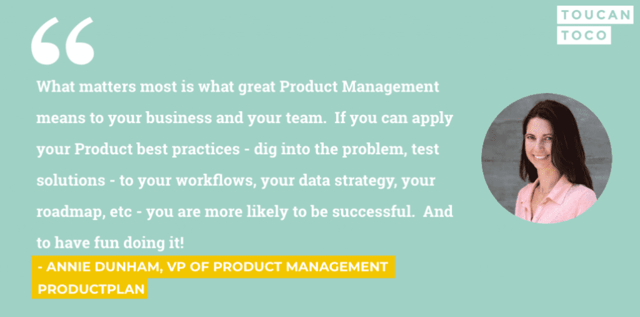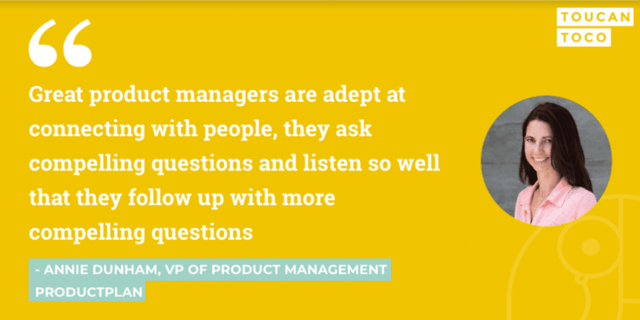
1. Tell us a bit about yourself !
I’m Annie Dunham, the Vice President of Product at ProductPlan. I have worked with product and engineering teams for the last 15 years to bring technology products to market. Prior to ProductPlan, I worked with teams at Elite Meetings, LogicMonitor, BlueCasa Communications and Microsoft. When I’m not pursuing customer insights or researching the latest on PM methodologies I can be found enjoying herself on a kiteboard or snowboard.
2. In one word or one sentence, how would you describe your product management style?
Adaptable
3. How did you get into product management?
The long winding road many of us take. I started in employee training with Vail Resorts, which translated to training for a Software company. I had the opportunity to try out writing code among other roles in software, and pursued Project Management because I liked bringing together the common threads from multiple disciplines. From there I learned about Product Management, moved into my first role in SaaS and haven’t looked back.
4. What are one or two things you typically do during the first hour of your day that lead to a productive day?
The first hour of my day always includes two things. One is a list of the most important things I can focus on today, and making sure I have time blocked in my calendar to address the top two. The other is using the quiet time for any creative thinking. By setting aside some time in the morning, I’m both able to slot projects that come up for that time and make the most out of the time when I think best.
5. How would you explain Product Management to a 5-year-old?
I tell my daughter that what I do is make sure that the things like the apps on her iPad are actually something that she wants to use. That it is my job to make sure that my company can (and does) build tools that are useful for our customers.
6. What are some of the qualities of great product managers?
I love interviewing for product management roles, because great product managers are incredibly fun to talk to! To be great at product management, you have to be innately curious, which is commonly apparent among personal and professional interests. You likely have many strong beliefs that are possibly loosely held, meaning you’re happy to share an opinion but with compelling data or evidence you’re open to changing your mind. Possibly most importantly, great product managers are adept at connecting with people, they ask compelling questions and listen so well that they follow up with more compelling questions. A great PM will help push our boundaries, or stretch our teams in a different direction, and the first evidence of this is if they make me think about the role or our business in a different way during the interview.
7. What has made you successful in your role?
In all honesty, part of it has been luck. Having the opportunity to work with great teams, building great products, is what makes Product Management fun. When you’re having fun, it’s easier to tap into the creativity and collaboration, to build alignment, and to engage customers. But overall, I think what has contributed most to my success has been recognition that Product is a people role, and that by taking the time to get to know each team, what they need, and what motivates them you can adapt any product process to create a highly effective culture.
8. How can PMs stay ahead of user requirements or make sure they’re aware of them early?
Talk to your customers, and dedicate time to hang out where they are (slack communities, review sites, etc). This can be one of the hardest parts of the role, because there are always urgent matters that consume the time, but it’s also one of the most important. Our PM team has weekly commitments around customer contacts, even if there isn’t a research project in motion. Similarly we have peers across the organization that each member of the PM teams spends time with weekly to stay on top of trends, whether they’re coming in through existing customers or prospects. It can be easy to get lost in the weeds of everything that has to happen, make sure you dedicate time to just learn and connect with customers and their evolving needs.
9. How would you prioritize your resources when you have two important things to do but can’t do them both?
When it feels like I’m trying to make a choice between two equally important initiatives, I usually take that as a sign that I need more information. There is always something that helps define why one initiative is a higher priority than another, but it may be a few steps deeper than our prioritization framework. If both items have a score of 85, it’s time for me to dig more and ask more questions. For example:
- Do both of these initiatives contribute to the same business objective? If not, which business objective has a higher priority right now?
- Are their dependencies or decisions that are impacted by approaching one initiative first? For example, if we tackle initiative A first will it make initiative B move much more quickly, or free a team up for a bigger initiative in a following sprint?
- Are there other benefits that may be less tangible? For example, is there an engineering squad that is energized about one topic, or other *people* benefits of tackling one project over the other.
There may be a case where they are equal across the board, in which case it’s time to just pick one and move on. Don’t let decision paralysis keep you from moving forward.
10. One of your highest paying customers demands a feature from you that isn’t on your roadmap…what do you do?
As with most things in product, it depends. From the product side, the first thing I do is make sure I have the full picture. I start with these questions:
- What is the financial impact if we are able to keep this customer happy?
- How does this request align with our product vision and trajectory? If it isn’t moving us in the right direction, the distraction is very risky.
- What is the scope of this project? If we take it on, what do we have to delay?
- There is a case where moving an item on the roadmap actually benefits many customers, and has a low opportunity cost. Similarly, you may find that while keeping this customer happy today, addressing their request will actually have an overall negative impact to your business. Once you understand the impact of the decision, make sure to share the why.
11. How do you know if a product is well-designed?
A well designed product will meet the user where they are in their experience, and make it easy to discover new uses or functionality throughout the process. A camera is a great example. Most users start with wanting to take a picture, and that is dead simple. But as they get more used to the device, be it a phone, SLR camera, or other, they want to take better pictures. Are the tools available to them easy to discover and try out? Once they have great pictures, the user may want to share, and the great camera will be one that makes that functionality obvious. Great products anticipate the needs of the user beyond the initial purchase and meet them in their journey.
12. How do you make sure/ know you have a solid roadmap?
The best way to understand the value of your roadmap, or how well it is doing its job, is to look at the questions you are getting from stakeholders and customers. When a roadmap does not have the right level of detail or context, questions tend to focus around ‘why’ – Why are we doing this? Why is this being done and not that? You know you’ve nailed the right level of detail when the questions evolve into “what’s next?” or “can we get into beta?” With the right level of alignment and context, roadmaps can be a place to start building energy, opposed to something you have to defend…
13. What are some common mistakes you see product teams making?
Jumping to solution mode – and this doesn’t just apply to solving the customer problem. Teams are getting better and better and understanding the customer problem, validating solutions, and iterating the way to success. This can also apply to all the other parts of Product Management. Don’t do things just because it’s recommended as a best practice somewhere, or in a new framework. There are 100’s of suggestions around how to be great at Product Management, and they all have value, but what matters most is what great Product Management means to your business and your team. If you can apply your Product best practices – dig into the problem, test solutions – to your workflows, your data strategy, your roadmap, etc – you are more likely to be successful. And to have fun doing it.



